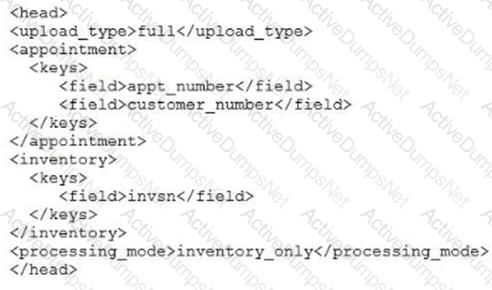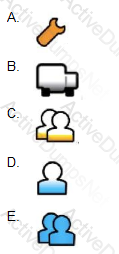A customer wants to ensure that their OFSC users' passwords are unique and as secure as possible Which four options are available in OFSC for making passwords unique?
Your customer wants toupdate technician inventory using the Inbound API using the following:

Given the
node of this request, which two statements are correct?Which two default attributes serve as stand-alone keys for work zones?
Your customer has enabled the setting 'Personalize the estimation of activity duration' for a given Resource Type.
What is the consequence of this setting for resources of that type?
Which two statements are correct regarding the use of planned capacity management?
Which statement is correct regarding Time Slots in Oracle Field Service Cloud (OFSC)?
Which statement is true regarding Travel Areas in OFSC?
A customer wants to integrate OFSC with their existing DBaaS instance.
Which option lists the steps necessary to take to set up the real-time transfer of OFSC data directly into DBaaS?
The key values for one of your work zones have changed and you need to update that work zone via a Metadata API call.
The problem is that some of the new key values might already be associated with other work zones, thereby creating potential conflicts.
What are you required to do within the "Replace Work Zone" API call to ensure that the keys sent in the request are the true values to be associated with the work zone you are updating?
Your customer is currently closing booking automatically for their Capacity Categories but they want to be able to close booking per work zone because some of their work zones require additional work preparations.
Which step is required to enable this functionality?
A dispatcher notices that there are a lot of yellow dots within the resource trace route on the map of their technicians.
Upon investigation, they find out that their technicians occasionally have to stop forabout five minutes to verify the equipment in their truck enlroute to a customer site. It is determined that this Is acceptable behavior and should not be flagged on the resource trace.
Which configuration setting will ensure that these 5-minute stops along the route do not result in yellow dots displaying on the Map view?
Which three configurations will enable booking to automatically close?
A company has technicians in a local Austin office in the United States, which has beenconfigured as a bucket within Oracle Field Service Cloud (OFSC).
They want all of their technicians to be able to work within the AUSTIN_SOUTHWEST work zone, but also need just the technicians Sandra Bernstein and Larry Johnson to be able to work within the AUSTIN_NORTHWEST work zone as well.
Which work zone configuration option meets these requirements?
Which option must you select when you are associating a preconfigured calendar to a resource that is made up of a combination of shifts and nonworking time?
Which three Resource Type Roles can share work skills, inventory, and geolocation in teamwork?
Which two settings must be configured to ensure that an alert will display in the Dispatch Console when a resource does NOT activate their route on time?
While most field resources for a particularcompany should see the countdown that displays the estimated time remaining for an activity in Oracle Field Service Cloud (OFSC), their 'contractor resources' that only perform periodica work should NOT see it.
Which configuration supports the requirementto hide the countdown timer for those 'contractor resources' that do NOT need to see it when they are working on their assigned activities?
Yourcustomer wants to configure an inner step message ("B") to send an email if a previous message ("A ) has Failed.
Which statement explains how this can be supported?
When receiving the Resource Tree, Which icon represents a "normal" load of activities for a field resource?
